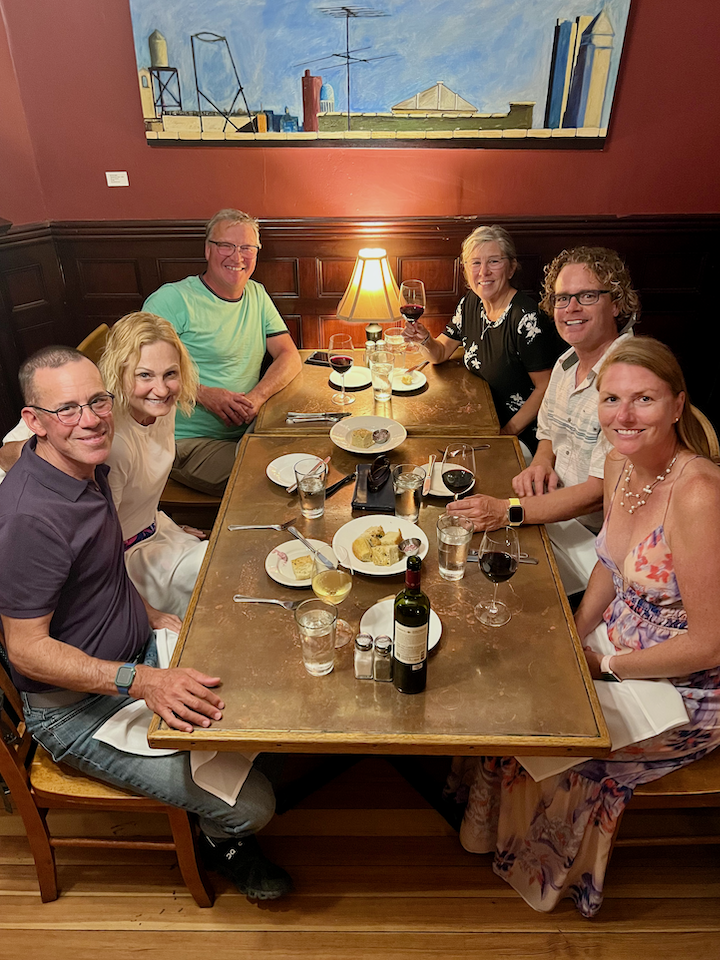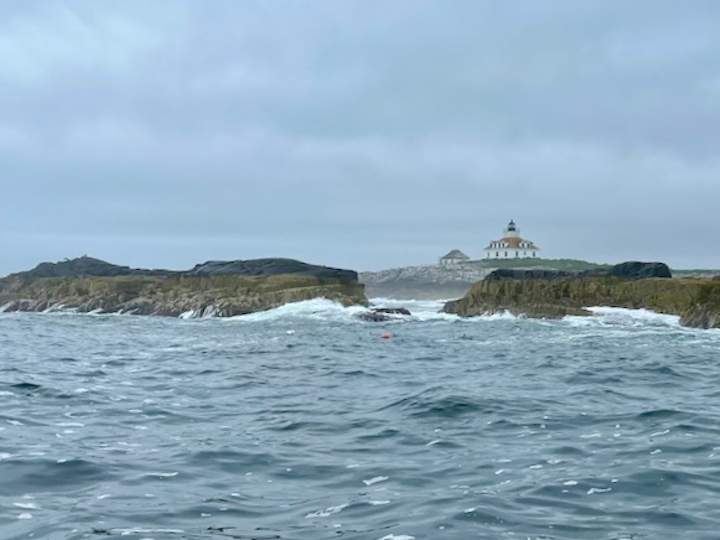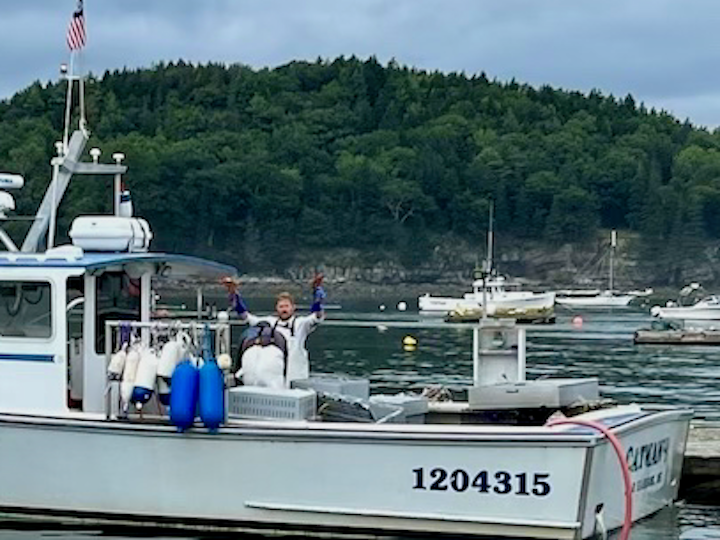WARNING: This post is longer than usual but, if you’re interested in lobstering, please read on!
After a night riding out the storm and hoping our anchor didn’t drag, the morning finally brought some calm. That is until we heard the growl of a diesel engine a few feet outside of the boat. We ran up on deck (still in pajamas) to see what terrible collision was about to occur and to prepare to abandon ship.
Well, rest assured, the boat is still afloat and we’re all fine. It was a lobster boat coming to tend traps that were a few feet away from where we were anchored. Why, you might ask, would we anchor so close to a lobster trap? There’s no choice! They’re everywhere! Anyway, we had front row seats as the captain and sternman of Catman were tending to traps in the area.
We’ve always been fascinated by the lobstering industry. So to further learn about it, we took a tour on a working lobster boat that has been slightly modified to take visitors along. We hauled and set traps while learning about the trade and observing other wildlife including two bald eagles, numerous seals and a wide variety of sea birds.
As mentioned in a prior post, there are 5,500 lobster boats in Maine, handling 3,000,000 traps. In spite of the apparently random approach to laying traps everywhere, the industry is highly regulated, both by the Maine Department of Marine Resources, and by an unwritten code of ethics that has governed lobstering long before the government got involved. This dual system of governance reminded Dan of certain countries in Africa he visited, where tribal law has equal weight to official government law. Here are a few examples. To simplify, in this post, ‘lobsterman’, ‘sternman’, ‘he’, ‘his’ and ‘him’ refer to men or women, and there are many women in the trade.
- Issuing licences
- The number of traps per license (up to 800)
- The area in which traps can be set (hard to believe this is actually regulated)
- The minimum and maximum size of lobsters that can be kept
- How to handle fertile or egg bearing lobsters
- The nature of the gear used with the traps (lines, buoys, etc.)
The reason for not keeping small or egg-bearing lobsters is self-explanatory but we were curious as to why not big lobsters. The reason is that these lobsters have survived very harsh conditions over years or decades, so they are considered “studs” and left to continue to reproduce with all their qualities.
Each lobsterman adopts a unique color combination for his buoys. He must display one of these buoys on the cabin roof of his boat while tending traps. Poaching, moving or otherwise disturbing others’ traps is illegal, and worse, would bring the wrath of the community upon the offender.
Lobstermen keep an eye on each other. So while it’s often described as a loner activity, if one ever steps out of bounds, he can be sure others will have seen the transgression and will be waiting at the dock to reprimand him. Fines for not complying with the rules, such as keeping a non-keeper, range from hundreds to thousands of dollars.
Once traps are set for the first time, the process for tending them is more or less as follows:
- Locating the trap by using GPS marks recorded last time the trap was set, then visually identifying the buoy by its color code
- Lifting the buoy with a gaff (stick with a hook on the end). This is usually done by the captain, and always on the starboard side of the boat since he needs constant access to the wheelhouse, also on the starboard side.
- Feeding the line through an overhead block (pulley) slightly outboard and into a specialized electric winch that assists lifting the trap, which can be hundreds of feet below the surface and is very heavy. There’s usually a brick in the trap to keep it on the bottom.
- Pulling the trap onto the side deck. Now, the sternman takes over, opening the trap, removing the catch, throwing back undesirable animals, such as crabs (yes, Maine lobsterman hate crabs as they consume the bait before lobsters can), and throwing back the lobsters that aren’t keepers (too small, too big, egg-bearing, etc.)
- The sternman then puts bait, which is salted, slightly rotten herring (smells wonderful… that is if you’re a lobster), in the trap and shoves it back overboard, while the captain marks the spot for next time.
Keepers’ claws are banded so they won’t destroy each other in the hold. Lobsters are cannibals so if their claws are left alone, they would destroy each other. A notch is put in the tail of egg-bearing females before throwing them back so that if she’s ever fished again, she‘ll be thrown back immediately, whether or not she’s carrying eggs at that time. This is because she’s known to be fertile.
Watch the video at the end of this post for a visual sense of some of the above.
Some interesting factoids follow. Note that the yield and value stats are from a particularly good year, and can vary widely.
- Annual yield: 100,000,000 lbs (45,000,000 kgs)
- Value of annual yield (price off boat): $750,000,000
- Portion of yield exported: 85%
- Eggs carried by a female lobster: tens of thousands at a time
- Newborns surviving to legal age: 0.004% (2 / 50,000)
- Lobsters can be left or right handed determined by which claw is for crushing and which is for tearing
- If a lobster loses a claw, it will grow back
- Lobsters will eat other lobsters
- A mother will eat her newborns
- Lobsters molt as they grow
- Lobsters mate during molting before a new hard shell grows back
- Females secrete hormones that seduce, then sedate males
- Lobsters urinate below their eyes
If you’re interested in lobsters and lobstering, this is a great book to read: The Secret Life of Lobsters, by Trevor Corson.
After our lobstering experience, we enjoyed some rare warm, sunny weather and explored Bar Harbor. Of course we had a lobster roll for lunch.
After African Queen IV’s water leak and True North’s diesel leak(s), it was now Amuleto’s turn to have an oil leak. It seems the seal between the engine and transmission is going bad. We think by monitoring and adding oil, she’ll be fine to get to Portland, but we’ll make some calls to nearby yards to see if we can get a repair before that leg of the journey.
A great day was topped off by a great evening when we got together on African Queen IV with Jon, Cheri, Hélène and Benoît for hors d’oeuvres, a nice relaxing conversation and lots of laughter. Benoît continues to make impressive progress with English. Sandy’s been practicing her French, which is sounding increasingly Québécois, and Dan is official interpreter.




Leave a Reply